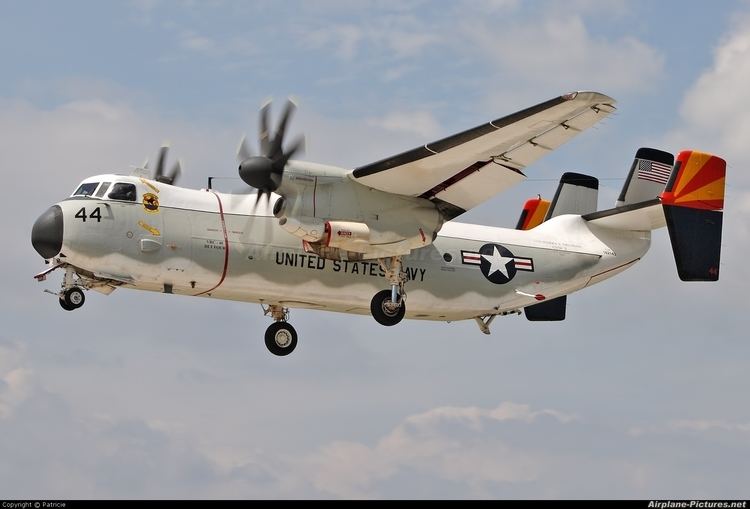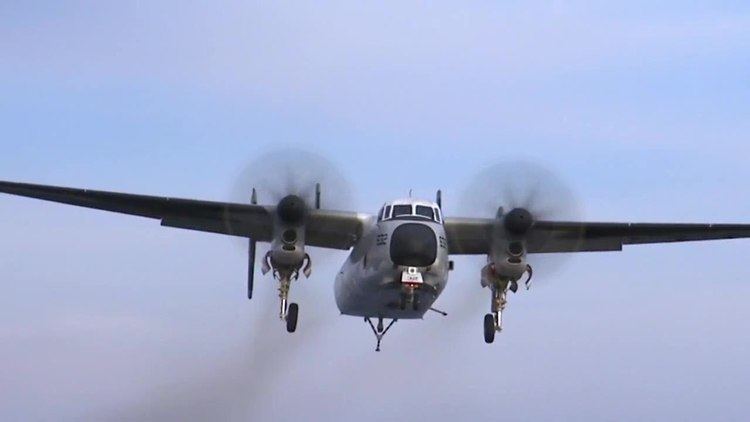Top speed 635 km/h Wingspan 25 m Unit cost 38,960,000–38,960,000 USD Manufacturers Grumman, Northrop Grumman | Range 2,400 km Length 17 m | |
 | ||
The Grumman C-2 Greyhound is a twin-engine, high-wing cargo aircraft, designed to carry supplies, mail, and passengers to and from aircraft carriers of the United States Navy. Its primary mission is carrier onboard delivery (COD). The aircraft provides critical logistics support to carrier strike groups. The aircraft is mainly used to transport high-priority cargo, mail and passengers between carriers and shore bases, and can also deliver cargo like jet engines and special stores.
Contents
- Origins
- Upgrades
- Operational history
- Replacement
- Variants
- Operators
- Accidents
- Specifications Reprocured C 2A
- References

Prototype C-2s first flew in 1964 and production followed the next year. The initial Greyhound aircraft were overhauled in 1973. In 1984, more C-2As were ordered under the name Reprocured C-2A or C-2A(R). The C-2As received updated propellers (from four to eight blades) and navigation.

Origins

The C-2 Greyhound, a derivative of the E-2 Hawkeye, shares wings and power plants with the E-2, but has a widened fuselage with a rear loading ramp. The first of two prototypes flew in 1964. After successful testing, Grumman began production of the aircraft in 1965. The C-2 replaced the piston-engined Grumman C-1 Trader in the COD role. The original C-2A aircraft were overhauled to extend their operational life in 1973.

Powered by two Allison T56 turboprop engines, the C-2A can deliver up to 10,000 pounds (4,500 kg) of cargo, passengers or both. It can also carry litter patients in medical evacuation missions. A cage system or transport stand restrains cargo during carrier launch and landing. The large aft cargo ramp and door and a powered winch allow straight-in rear cargo loading and unloading for fast turnaround. The Greyhound's ability to airdrop supplies and personnel, fold its wings, and generate power for engine starting and other uses provide an operational versatility found in no other cargo aircraft.

The C-2 has four vertical stabilizers, of which three are fitted with rudders. A single vertical stabilizer large enough for adequate directional control would have made the aircraft too tall to fit on an aircraft carrier hangar deck. The four-stabilizer configuration has the advantage of placing the outboard rudder surfaces directly in line with the propeller wash, providing effective yaw control down to low airspeeds, such as during takeoff and landing. The inner-left stabilizer lacks a rudder, with it sometimes have been referred to as the "executive tail", as it has nothing to do compared to the other three. A single C-2 (2797) was equipped with an air-to-air refueling probe but this was not installed in other aircraft.
In 1984, the Navy ordered 39 new C-2A aircraft to replace older airframes. Dubbed the Reprocured C-2A or C-2A(R) due to the similarity to the original, the new aircraft has airframe improvements and better avionics. The older C-2As were phased out in 1987, and the last of the new models was delivered in 1990.
Upgrades
The 36 C-2A(R)s underwent a critical Service Life Extension Program (SLEP). The C-2A(R)'s lifespan was 10,000 hours, or 15,000 carrier landings; plans require the C-2A to perform its mission supporting battle group operational readiness through 2015. The lower landing limit was approaching for most airframes, and the SLEP will increase their projected life to 15,000 hours or 36,000 landings. Once complete, the SLEP will allow the 36 aircraft to operate until 2027. The SLEP includes structural improvements to the center wing, an eight-bladed NP2000 propeller, navigational upgrades including the addition of GPS and the dual CAINS II Navigation System, the addition of crash-survivable flight incident recorders, and a Ground Proximity Warning System. The first upgraded C-2A(R) left NAVAIR Depot North Island on 12 September 2005, after sitting on the ground for three and a half years while the SLEP was developed and installed. All aircraft will receive SLEP by 2015.
In November 2008, the company also obtained a $37M contract for the maintenance, logistics and aviation administration services over five years for the C-2A fleet assigned to VX-20 test and evaluation squadron at Patuxent River. Northrop Grumman worked on an upgraded C-2 version, and offered to modernize the fleet with components common to the E-2D Hawkeye.
Operational history
Between November 1985 and February 1987, VR-24 (former Navy Transport Squadron) and its seven reprocured C-2As demonstrated the aircraft's exceptional operational readiness. The squadron delivered 2,000,000 pounds (910 t) of cargo, 2,000,000 pounds (910 t) of mail and 14,000 passengers in the European and Mediterranean theaters. The C-2A(R) also served the carrier battle groups during Operations Desert Shield and Desert Storm during the Gulf War, as well as Operation Enduring Freedom during the War in Afghanistan.
On 2 June 2011, the US Navy loaned two C-2A(R) Greyhounds from VRC-40 (USN BuNos 162143 & 162165) to the French Navy. The two aircraft were stationed at Toulon-Hyères Airport, Hyères to assist in improving the flow of logistics and supplies to the French aircraft carrier Charles de Gaulle operating in the Mediterranean Sea off Libya in support of the NATO intervention in Libya. After 16 days, both aircraft returned to the US via Shannon Airport, Ireland on 18 June 2011.
Replacement
The Common Support Aircraft was once considered as a replacement for the C-2, but failed to materialize. The USN was exploring a replacement for the C-2 in September 2009. Three options were suggested as replacements for the aging C-2s: a new batch of updated C-2s, a transport version of the Lockheed S-3 Viking, and the tilt-rotor Bell Boeing V-22 Osprey.
The C-2 competed with the V-22 Osprey for use as the future carrier onboard delivery (COD) aircraft. Northrop Grumman proposed modernizing the C-2 by installing the same wings, glass cockpit, and engines as the E-2D Advanced Hawkeye in two phases. The first would replace the engines and avionics, and the second would replace the wing structures. Installing the Rolls Royce T56-427A engines would cut fuel consumption by 13-15 percent with the same 8-bladed propeller; this would enable take offs with a 10,000-pound (4,500 kg) payload in 125 °F (52 °C) degree heat and a range in excess of 1,400 nmi (1,600 mi; 2,600 km), similar performance by the C-2A requires engine temperatures at 70 °F (21 °C), requiring trading fuel for payload. Adopting the E-2D's cockpit would deliver a 10 percent savings on lifetime logistical support. One of the Greyhound's most important features is its internal volume of 860 cubic feet (24 m3) of cargo space. Northrop Grumman stated that their approach could cost far less than the V-22 including $120 million from C-2 and E-2D commonality.
In February 2015, the Navy's FY 2016 budget confirmed the V-22's selection for the COD mission, replacing the C-2A. Procurement is to begin in 2018 and the Navy model of the aircraft is to be called the CMV-22B. 44 will be purchased and deliveries will start in 2020.
Variants
Operators
United States of America
Accidents
Specifications (Reprocured C-2A)
Data from U.S. Navy
General characteristics
Performance
